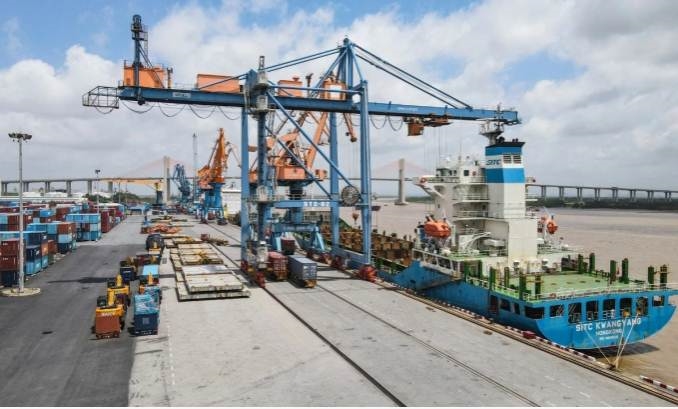Vietnam - China: Trade turnover in 10 months exceeds 208 billion USD
Wednesday, November 19,2025
AsemconnectVietnam - By the end of October 2025, bilateral trade turnover between Vietnam and China will exceed 208 billion USD, making Vietnam China's largest partner in Southeast Asia.
The information was given at the Vietnam - China Trade Promotion Forum organized by Center for Trade and Agriculture Promotion (Ministry of Agriculture and Environment) on afternoon of November 12.
Expanding opportunities for Vietnamese agricultural products in the Chinese market
Vietnam possesses abundant, diverse and high-quality agricultural, forestry and fishery resources, which are highly appreciated by international consumers. With a dynamic economy, stable growth and active participation in many regional and global free trade agreements, Vietnam is increasingly affirming its important role in global food security and the international agricultural value chain.
In recent years, Vietnam-China trade relations have developed rapidly, stably and substantially. In 2024, bilateral turnover reached 205.2 billion USD, an increase of 19.3% over the previous year; by the end of October 2025, it exceeded 208 billion USD. Vietnam is China's largest trading partner in Southeast Asia and ranked fourth worldwide.
Mr. Hoang Van Du, Deputy Director of Agricultural Trade Promotion Center, emphasized that this result is a testament to close cooperation between the two countries' governments, along with dynamism and ability to seize opportunities of businesses. Bilateral and multilateral agreements have created a favorable legal corridor, promoting two-way trade and investment.
In agricultural sector, cooperation has achieved many encouraging results: Agricultural import and export turnover has grown steadily, and Vietnam's key products such as fruits, seafood, rice, coffee, pepper, and rubber are widely available in China. In contrast, Vietnam imports large quantities of machinery, equipment, materials, fertilizers, chemicals, and processing technology from China to serve production and improve agricultural productivity.
Chinese enterprises are increasingly interested in investing in Vietnam, especially in fields of processing, preserving agricultural products, and high-tech agriculture. Chinese government also affirmed that it will continue to expand import of Vietnamese agricultural products and encourage businesses on both sides to strengthen large-scale, high-quality investment cooperation. This is an important opportunity for Vietnam's key products such as fruits, coffee, cashew nuts, and seafood to expand their market share in China, a market with huge and continuously increasing consumption demand.
“The trade promotion forum is an opportunity for industry associations and businesses to exchange information, connect supply and demand, seek investment opportunities, transfer technology and develop markets. At the same time, it opens up a new space for cooperation to improve the quality, safety and added value of Vietnamese agricultural products, towards green, clean and sustainable agriculture,” Mr. Du emphasized.
Technology and infrastructure will be the foundation for modern agriculture
Sharing at the Forum, Ms. Te Binh, General Director of Sunwah Gelafood Supply Chain Management Company, said that the infrastructure and transportation network between Vietnam and China are gradually improving, especially road and rail transport, helping to increase efficiency and convenience in transporting agricultural products between the two countries. In recent years, Vietnamese agricultural products exported to China have become increasingly diverse. Among them, durian is becoming a popular product among Chinese consumers, while Vietnamese bird's nest meets the demand for nutritious food, occupying a significant market share in this market.
In addition, products such as dried fruits and dried vegetables have also penetrated deeply into Chinese market, providing more diverse choices for consumers and contributing to enriching the list of imported agricultural products. These results clearly demonstrate the great potential and open prospects of bilateral agricultural cooperation between the two countries. In addition to agricultural products, Chinese agricultural equipment and machinery with reasonable prices and high applicability have also met the needs of the Vietnamese market, effectively supporting the production and processing of agricultural products in the country.
“In future, two sides can continue to exploit potential, expand brands, products and agricultural equipment, and promote cooperation in scientific research and development of new technologies in the agricultural sector. This cooperation does not stop at machinery, but can be expanded to the entire agricultural value chain, from production, processing to consumption,” Ms. Te Binh shared. According to Mr. Le Thanh Hoa, Deputy Director of the Department of Quality, Processing and Market Development, Vietnam with more than 100 million people and China with more than 1.4 billion people both have large demand for agricultural products. According to FAO, by 2030, Asia-Pacific region needs to increase agricultural output by at least 30%. Despite impact of climate change and market fluctuations, Vietnam's agricultural sector still maintains stable growth. Vietnam's agricultural, forestry and fishery exports will continuously grow from 41.4 billion USD in 2020 to more than 62.5 billion USD in 2024, an increase of over 18.7% compared to 2023.
China currently accounts for about 25% of Vietnam's total agricultural trade turnover. In the first 9 months of 2025 alone, total bilateral agricultural import-export turnover reached 14 billion USD, an increase of 8.5% over the same period in 2024; of which exports reached 10.3 billion USD, an increase of 5.1%. With a close geographical location, similar culture and consumer tastes, trade relations are shifting from informal exports to formal, modern and sustainable ones.
To meet the requirements of traceability, quality standards and food safety, Vietnam has invested heavily in digital transformation, AI, electronic traceability systems, cold chain technology and smart logistics. This is the foundation to help improve the competitiveness of Vietnamese agricultural products in the Chinese and international markets.
Current challenges include unsynchronized border logistics infrastructure, limited preservation capacity, fragmented production, and uneven quality. Mr. Hoa said that the two countries need to strengthen systematic cooperation, associated with technology transformation and modern standards.
Key solutions include: Trade promotion and product promotion, connecting businesses through fairs, forums, market communications; technical cooperation, quarantine, biosafety and transport of goods according to international standards, ensuring safe and smooth trade flows across borders; linking value chain investments, focusing on deep processing, cold logistics, e-commerce, standardizing raw material areas; forming distribution centers and processing zones linked to border areas, optimizing costs and improving supply chain efficiency.
At the Forum, management agencies, experts, and businesses commented that Vietnam-China agricultural trade not only has economic significance but is also a symbol of trustworthy cooperation, friendship and mutual development. With the potential, advantages and consensus within the ASEAN - China cooperation framework, the two countries have the basis to build a modern, safe and sustainable agricultural supply chain, making practical contributions to regional food security and the common prosperity of Asia.
Source: Vitic/ congthuong.vn
Expanding opportunities for Vietnamese agricultural products in the Chinese market
Vietnam possesses abundant, diverse and high-quality agricultural, forestry and fishery resources, which are highly appreciated by international consumers. With a dynamic economy, stable growth and active participation in many regional and global free trade agreements, Vietnam is increasingly affirming its important role in global food security and the international agricultural value chain.
In recent years, Vietnam-China trade relations have developed rapidly, stably and substantially. In 2024, bilateral turnover reached 205.2 billion USD, an increase of 19.3% over the previous year; by the end of October 2025, it exceeded 208 billion USD. Vietnam is China's largest trading partner in Southeast Asia and ranked fourth worldwide.
Mr. Hoang Van Du, Deputy Director of Agricultural Trade Promotion Center, emphasized that this result is a testament to close cooperation between the two countries' governments, along with dynamism and ability to seize opportunities of businesses. Bilateral and multilateral agreements have created a favorable legal corridor, promoting two-way trade and investment.
In agricultural sector, cooperation has achieved many encouraging results: Agricultural import and export turnover has grown steadily, and Vietnam's key products such as fruits, seafood, rice, coffee, pepper, and rubber are widely available in China. In contrast, Vietnam imports large quantities of machinery, equipment, materials, fertilizers, chemicals, and processing technology from China to serve production and improve agricultural productivity.
Chinese enterprises are increasingly interested in investing in Vietnam, especially in fields of processing, preserving agricultural products, and high-tech agriculture. Chinese government also affirmed that it will continue to expand import of Vietnamese agricultural products and encourage businesses on both sides to strengthen large-scale, high-quality investment cooperation. This is an important opportunity for Vietnam's key products such as fruits, coffee, cashew nuts, and seafood to expand their market share in China, a market with huge and continuously increasing consumption demand.
“The trade promotion forum is an opportunity for industry associations and businesses to exchange information, connect supply and demand, seek investment opportunities, transfer technology and develop markets. At the same time, it opens up a new space for cooperation to improve the quality, safety and added value of Vietnamese agricultural products, towards green, clean and sustainable agriculture,” Mr. Du emphasized.
Technology and infrastructure will be the foundation for modern agriculture
Sharing at the Forum, Ms. Te Binh, General Director of Sunwah Gelafood Supply Chain Management Company, said that the infrastructure and transportation network between Vietnam and China are gradually improving, especially road and rail transport, helping to increase efficiency and convenience in transporting agricultural products between the two countries. In recent years, Vietnamese agricultural products exported to China have become increasingly diverse. Among them, durian is becoming a popular product among Chinese consumers, while Vietnamese bird's nest meets the demand for nutritious food, occupying a significant market share in this market.
In addition, products such as dried fruits and dried vegetables have also penetrated deeply into Chinese market, providing more diverse choices for consumers and contributing to enriching the list of imported agricultural products. These results clearly demonstrate the great potential and open prospects of bilateral agricultural cooperation between the two countries. In addition to agricultural products, Chinese agricultural equipment and machinery with reasonable prices and high applicability have also met the needs of the Vietnamese market, effectively supporting the production and processing of agricultural products in the country.
“In future, two sides can continue to exploit potential, expand brands, products and agricultural equipment, and promote cooperation in scientific research and development of new technologies in the agricultural sector. This cooperation does not stop at machinery, but can be expanded to the entire agricultural value chain, from production, processing to consumption,” Ms. Te Binh shared. According to Mr. Le Thanh Hoa, Deputy Director of the Department of Quality, Processing and Market Development, Vietnam with more than 100 million people and China with more than 1.4 billion people both have large demand for agricultural products. According to FAO, by 2030, Asia-Pacific region needs to increase agricultural output by at least 30%. Despite impact of climate change and market fluctuations, Vietnam's agricultural sector still maintains stable growth. Vietnam's agricultural, forestry and fishery exports will continuously grow from 41.4 billion USD in 2020 to more than 62.5 billion USD in 2024, an increase of over 18.7% compared to 2023.
China currently accounts for about 25% of Vietnam's total agricultural trade turnover. In the first 9 months of 2025 alone, total bilateral agricultural import-export turnover reached 14 billion USD, an increase of 8.5% over the same period in 2024; of which exports reached 10.3 billion USD, an increase of 5.1%. With a close geographical location, similar culture and consumer tastes, trade relations are shifting from informal exports to formal, modern and sustainable ones.
To meet the requirements of traceability, quality standards and food safety, Vietnam has invested heavily in digital transformation, AI, electronic traceability systems, cold chain technology and smart logistics. This is the foundation to help improve the competitiveness of Vietnamese agricultural products in the Chinese and international markets.
Current challenges include unsynchronized border logistics infrastructure, limited preservation capacity, fragmented production, and uneven quality. Mr. Hoa said that the two countries need to strengthen systematic cooperation, associated with technology transformation and modern standards.
Key solutions include: Trade promotion and product promotion, connecting businesses through fairs, forums, market communications; technical cooperation, quarantine, biosafety and transport of goods according to international standards, ensuring safe and smooth trade flows across borders; linking value chain investments, focusing on deep processing, cold logistics, e-commerce, standardizing raw material areas; forming distribution centers and processing zones linked to border areas, optimizing costs and improving supply chain efficiency.
At the Forum, management agencies, experts, and businesses commented that Vietnam-China agricultural trade not only has economic significance but is also a symbol of trustworthy cooperation, friendship and mutual development. With the potential, advantages and consensus within the ASEAN - China cooperation framework, the two countries have the basis to build a modern, safe and sustainable agricultural supply chain, making practical contributions to regional food security and the common prosperity of Asia.
Source: Vitic/ congthuong.vn
Pangasius exports at end of this year: Great opportunities from CPTPP and Middle East
Golden opportunity for Vietnamese agricultural products in US market
Imports of goods from Germany in first 10 months of 2025
Exports to France in 10 months of 2025 grew
Fruit and vegetable import markets in 10 months of 2025
Exports to China reached over 56.9 billion USD in 10 months of 2025
LPG imports worth over 1.7 billion USD in 10 months of 2025
Warning from EU of 50% reduction, Vietnamese agricultural products record quality improvement
'Hot' development makes fresh coconut exports gradually lose their advantage
Exports to UK reached over 7 billion USD in first 10 months of 2025
Exports to Japan in 10 months of 2025 increased
Exports to Sri Lanka reached 225.4 million USD in 10 months of 2025
FDI enterprises account for more than 72% of Vietnam's import-export turnover
Go Global - driving force for Vietnam's export breakthrough

Plan of Hai Duong province for a period of 2021 - 2030, ...
Organize space reasonably and harmoniously, focusing on connecting Hai Duong in common development space, actively contributing to the ...Plan of Hau Giang province in a period of 2021 - 2030, ...
Sustainable forestry development program in a period of ...

LION Championship 25 to feature title showdowns in Khanh ...
LION Championship 25 will take place at Cam Ranh Square in south-central Khanh Hoa province, at 20:00 on August 16, featuring two of the ...Bai Dinh Pagoda named outstanding destination with ...
Party chief attends special political–art programme “Under ...



